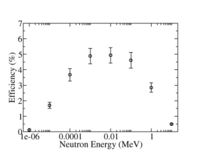Difference between revisions of "Forest He-3 Tubes"
| Line 5: | Line 5: | ||
About 764 keV of energy is liberated in this nuclear reaction and distributed between the final products according to their masses. | About 764 keV of energy is liberated in this nuclear reaction and distributed between the final products according to their masses. | ||
| − | + | ;Cons Momentum <math>\Rightarrow</math> | |
| − | + | : <math>m_p v_p = m_{H^3} v_{H^3} \Rightarrow v_p = 3v_{H^3}</math> | |
Because the proton is about a factor of 3 lighter than Tritium (H^3) , it will have more kinetic energy by about a factor of 3 (about 573 keV). This liberated proton can ionize other He-3 atoms via the reaction | Because the proton is about a factor of 3 lighter than Tritium (H^3) , it will have more kinetic energy by about a factor of 3 (about 573 keV). This liberated proton can ionize other He-3 atoms via the reaction | ||
Revision as of 14:12, 11 June 2008
Thermal neutron capture of He-3 may be represented by the reaction below
About 764 keV of energy is liberated in this nuclear reaction and distributed between the final products according to their masses.
- Cons Momentum
Because the proton is about a factor of 3 lighter than Tritium (H^3) , it will have more kinetic energy by about a factor of 3 (about 573 keV). This liberated proton can ionize other He-3 atoms via the reaction
The same proton will ionize several He-3 atoms when dissipating the 573 keV kinetic energy. Once you have the creation of ions, you can construct detectors to collect and measure the electrons.
The Tritium (H^3) can also ionize the gas but due to its higher mass it does not travel as far (shorter range) as the proton and makes a smaller contribution to the ionization signal. Tritium decays to He-3 after about 12 years ( neutron is converted to proton)
reference: J. W. Leake, "Nuclear Instruments and Methods", Vol. 63, page 329, 1968).
The probability of neutron capture is measured in terms of a cross section. There is a nuclear data base for neutron capture located at LBL. The "free" neutron thermal total cross section () is barns ( 1 barn = ).
- Total cross section is defined as
where
- = density of the He-3 target
- L = length of the target.
10-atm He-3, 2.54 cm diameter tube, 76 cm long, poly moderator, cadmium metal, Boron loaded shielding.
